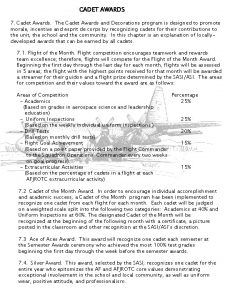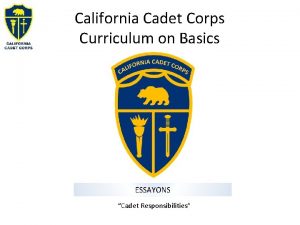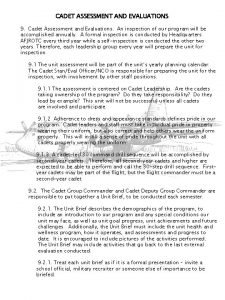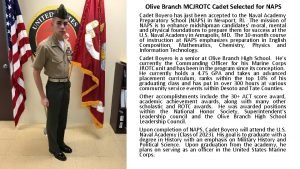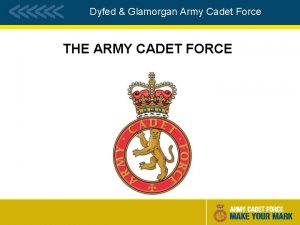The Cadet Officer Cadet Joshua Pravel Overview a





















- Slides: 21

The Cadet Officer Cadet Joshua Pravel

Overview a. Speaking the Language of Leadership b. Communication: The first step in leading others c. The Cadet Flight Commander: Small unit leadership a. Training Plan Sample d. Leadership and the NCO: Leading those who lead

Speaking the Language of Leadership AIR FORCE DEFINITION OF LEADERSHIP "Leadership is the art to of influencing and directing people in such a way that will win their obedience, confidence, respect and loyal cooperation in achieving common objectives. "

Speaking the Language of Leadership Cont. "Leadership is the art of. . . " a. Leadership is an art • Stick to what you know • Remain consistent

Speaking the Language of Leadership Cont. ". . . Influencing and directing people. . . " a. Influencing is leading by example • Directing is implementing your standards • Treat your cadets as people • Use ALL of your team.

Speaking the Language of Leadership Cont. "in such a way that will win their obedience, confidence, respect and loyal cooperation" a. Win, not force • Obedience, Confidence, and Respect • Loyal cooperation

Speaking the Language of Leadership Cont. ". . . In achieving in common objectives. " a. Work together o Do not let friendly competition get in the way of accomplishing the mission • Keep your people informed

Communication: The first step in leading others "Vision without action is a dream. Action without vision is a nightmare. " - Japanese Proverb

Communication: The first step in leading others a. Establish a vision b. Mentor your cadets c. Schedule regular meetings with staff d. Ask questions

The Cadet Flight Commander: Small Unit Leadership PREPARATION a. Schedule regular meetings • Train your flight sergeant • Understand the age and experience of your people • Anticipate issues - develop a week by week training plan • Ask your C/CC or C/CD for input

The Cadet Flight Commander: Small Unit Leadership WHILE IN THE ROLE a. First, explain your vision • Set standards early with deadlines • Always give second chances • Work your plan

The Cadet Flight Commander: Small Unit Leadership Cont. FLIGHT TRAINING PLAN A training plan is a written document that accompanies the training syllabus used to understand the method of training rather than the material being taught.

The Cadet Flight Commander: Small Unit Leadership Cont. TRAINING PLAN USES a. Organizes thoughts according to your style of leadership • Reduces dead time

ZULU FLIGHT TRAINING PLAN C/2 d Lt Pravel - C/TSgt Gardiner Activity: Drill instruction (30 minutes) Flight Notes - Show 5 minute drill video - Give time for cadets to ask questions - Address cadets firmly, not aggresively - Understand misunderstanding - Give cadets water halfway through Individual Notes - Periodically quiz cadets (Including Staff) - Review Drill manual for proper instruction - Assist C/Gardiner as needed - Answer questions firmly rather than aggresively

The Cadet Flight Commander: Small Unit Leadership Cont. CORRECTION vs DISCIPLINE a. Correction is addressed to the group and is usually performed by the flight sergeant. o Examples: Uniform infraction, failure to salute and officer, looking around at attention, etc. • Discipline is usually done in private and usually performed by the flight commander o Examples: Insulting a staff member, swearing in uniform, overall disrespect. • Correct with the intent of understanding flight understanding

Leadership and The NCO: Leading Those Who Lead GENERAL TIPS a. Relationship is built on respect • Establish a common vision • Discuss your expectations (ask his expectations of you) • Understand that the NCO may use a different leadership style • NCO will need assistance. Assist when needed

Leadership and the NCO: Leading Those Who Lead Cont. a. Your leadership style will vary depending on cadet Experience o Cadets will be anywhere from C/SSgt to C/CMSgt • Your leadership style will vary depending on cadet maturity o Cadets will age anywhere from 12 -21 years old

Leadership and The NCO: Leading Those Who Lead Cont. HERSEY AND BLANCHARD SITUATIONAL LEADERSHIP MODEL a. S 1: Telling - One-way communication in which the leader defines the roles of the individual or group • S 2: Selling- Two-way communication in which the leader convinces his subordinates that his/her idea is the best course of action. • S 3: Participating - Shared decision making about aspects of how the task is accomplished. • S 4: Delegating - The process and responsibility has been passed to the individual or group. The leader stays involved to monitor progress. o It still remains the leader's duty

Leadership and The NCO: Leading Those Who Lead Cont. MANAGEMENT LEVELS a. M 1 - The person lacks the specific skills required for the job in hand are unable and unwilling to do or to take responsibility for this job or task. • M 2 - They are still unable to take on responsibility for the task being done; however, they are willing to work at the task. • M 3 - They are experienced and able to do the task but lack the confidence to take on responsibility. • M 4 - They are experienced at the task, and comfortable with their own ability to do it well. They are able and willing to not only do the task, but to take responsibility for the task.

Leadership and The NCO: Leading Those Who Lead CLOSING NOTES a. Competence changes depending on the job o An experienced NCO could feel uncomfortable if they are new to a certain job • Just because the NCO is supposed to "get the job done" does not mean they know how to. o Mentor to ensure understanding

Questions?
 Quá trình desamine hóa có thể tạo ra
Quá trình desamine hóa có thể tạo ra độ dài liên kết
độ dài liên kết Các môn thể thao bắt đầu bằng tiếng nhảy
Các môn thể thao bắt đầu bằng tiếng nhảy Hình ảnh bộ gõ cơ thể búng tay
Hình ảnh bộ gõ cơ thể búng tay Khi nào hổ mẹ dạy hổ con săn mồi
Khi nào hổ mẹ dạy hổ con săn mồi điện thế nghỉ
điện thế nghỉ Dot
Dot Nguyên nhân của sự mỏi cơ sinh 8
Nguyên nhân của sự mỏi cơ sinh 8 Trời xanh đây là của chúng ta thể thơ
Trời xanh đây là của chúng ta thể thơ Chó sói
Chó sói Thiếu nhi thế giới liên hoan
Thiếu nhi thế giới liên hoan Tia chieu sa te
Tia chieu sa te Một số thể thơ truyền thống
Một số thể thơ truyền thống Thế nào là hệ số cao nhất
Thế nào là hệ số cao nhất Hệ hô hấp
Hệ hô hấp Lp html
Lp html Số nguyên là gì
Số nguyên là gì Tư thế ngồi viết
Tư thế ngồi viết đặc điểm cơ thể của người tối cổ
đặc điểm cơ thể của người tối cổ Cách giải mật thư tọa độ
Cách giải mật thư tọa độ Các châu lục và đại dương trên thế giới
Các châu lục và đại dương trên thế giới Tư thế worm breton
Tư thế worm breton
























